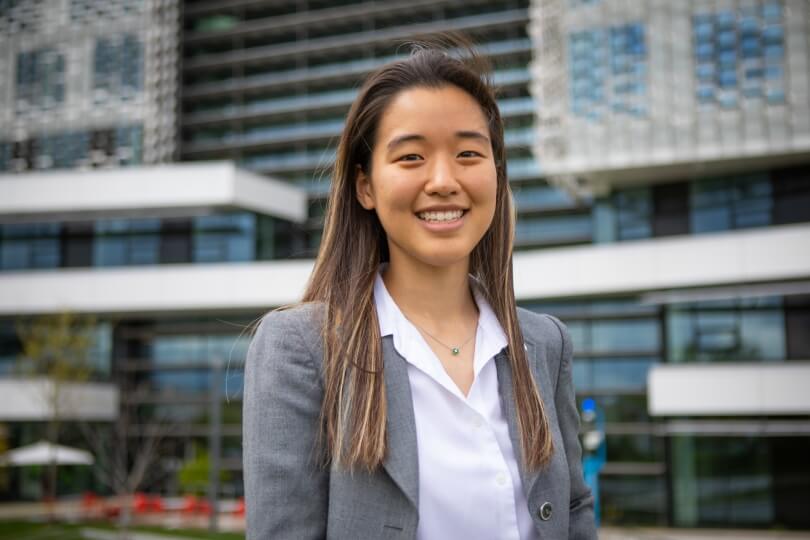Grace Kim, S.B. 23 in mechanical engineering. (Eliza Grinnell/SEAS)
Grace Kim knew she wanted to study engineering long before she arrived at Harvard. After taking “ES51: Computer Aided Machine Design,” the introductory mechanical engineering course, as a freshman at the Harvard John A. Paulson School of Engineering and Applied Sciences (SEAS), Kim realized engineering was more than just an academic interest; it was a passion, and one she would pursue beyond her four years here.
“I remember our ES51 Turf Wars competition and seeing the hundred different components we personally machined on our robot interact and come alive on the playing field. I cheered on our little robot as it scored almost all the ping pong balls on the field into its goal,” Kim said. “It was one of the most exciting moments I'd had in a while.”
That competition required multiple disciplines beyond the fundamentals of mechanical engineering. Kim, S.B. ‘23 ended up learning about electrical engineering and computer science as well, a multidisciplinary approach at the heart of all her favorite projects at SEAS. It’s the same reason she was drawn to the Harvard Students for the Exploration and Development of Space (SEDS) and Harvard Microrobotics Laboratory, where she’s devoted most of her extracurricular time over the last four years.
“I knew I wanted to mix space and robotics throughout my career,” she said. “There are also so many cool questions we can answer through aerospace engineering and space exploration.”
Growing up in Maryland, Kim had to navigate much of the college application process on her own as a First-Generation, Low-Income (FGLI) student. Harvard stood out from her other potential colleges because “even though the engineering community was small, it seemed like a really welcoming community. Between the engineering and FGLI communities, it’s easy to say I felt at home here within the first few days on campus.”
Upon arrival, Kim almost immediately joined Primus, a community for Harvard FGLI students. Mentorship from faculty and more senior students helped Kim thrive at Harvard, and she’s since tried to offer that same guidance to younger students arriving on campus. She eventually became president of the organization, connecting Primus with similar FGLI clubs all over the country for joint programming.
“Primus really helped me to remember that I can slow down,” Kim said. “It often seems that everyone is just running at Harvard. We’re all running so quickly towards our goals, even if we don’t always know what those goals are. But Primus helped me recognize the importance of taking the time to try to stop, pause, and familiarize myself with the community and resources around me. I’m trying for more of a walking pace than a full-on sprint.”
Whatever her pace, Kim has succeeded. The cube satellite she helped construct with SEDS was recently selected for launch through the NASA CubeSat Launch Initiative. Components Kim designed as a SpaceX intern last summer are already orbiting the earth on Starlink V2 satellites, and for a senior thesis, Kim worked on the two-year NASA Jet Propulsion Lab (JPL) project, designing a satellite to accompany the Europa Clipper mission. Her thesis went on to win a Dean’s Award for Outstanding Engineering Project.
“It’s really so exciting to see how much our SEDS team has grown from a few people to a fully built ground station and cube satellite bus components,” Kim said. “Our thesis seeks to answer really intriguing questions with NASA JPL’s Europa Clipper, which is going to send a spacecraft to Europa, one of Jupiter’s moons, and see if there’s water underneath the icy surface. I am both so ecstatic and thankful that we got to be part of this project with our thesis cube satellite.”
Kim will continue exploring her dual passions for robotics and space next year at the University of Cambridge. She was selected for a Marshall Scholarship, which allows U.S. students to pursue one- or two-year master’s degrees at universities in the United Kingdom. Kim will pursue a degree in advanced computer science, which combines topics such as satellite constellations, multi-robot systems, and machine learning.
“I haven’t been outside the U.S. except for a trip to Vancouver last summer, and I feel like I haven’t been exposed to as much of the international community as I could’ve been,” Kim said. “The U.K. is one small step towards me continuing to widen my perspective. Studying at Cambridge will open up a lot of exciting opportunities to work in space on an international scale. Something I hope we can change in the future as we continue to develop aerospace and space development and application is to make it a lot more collaborative on an international level.”
How this scholarship goes will determine what Kim does next. She could opt to continue her studies and pursue a Ph.D., but she could also return to the space industry or try to get a job with a government agency such as JPL. But whatever choices Kim makes in the coming years will be informed by the four years she spent learning, designing, and launching her way through college.
“Everyone here is incredibly supportive. So many people here are trying to lift each other up rather than pull each other down,” Kim said. “I’ve also been able to accumulate so many of these cool experiences only being a college student, and I don’t think it would’ve been possible for me to have all these life-changing opportunities if it wasn’t for my time at Harvard.”
Press Contact
Matt Goisman | mgoisman@g.harvard.edu
